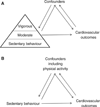Sedentary behaviour and cardiovascular disease: a review of prospective studies
- PMID: 22634869
- PMCID: PMC4582407
- DOI: 10.1093/ije/dys078
Sedentary behaviour and cardiovascular disease: a review of prospective studies
Abstract
Background: Current estimates from objective accelerometer data suggest that American adults are sedentary for ∼7.7 h/day. Historically, sedentary behaviour was conceptualized as one end of the physical activity spectrum but is increasingly being viewed as a behaviour distinct from physical activity.
Methods: Prospective studies examining the associations between screen time (watching television, watching videos and using a computer) and sitting time and fatal and non-fatal cardiovascular disease (CVD) were identified. These prospective studies relied on self-reported sedentary behaviour.
Results: The majority of prospective studies of screen time and sitting time has shown that greater sedentary time is associated with an increased risk of fatal and non-fatal CVD. Compared with the lowest levels of sedentary time, risk estimates ranged up to 1.68 for the highest level of sitting time and 2.25 for the highest level of screen time after adjustment for a series of covariates, including measures of physical activity. For six studies of screen time and CVD, the summary hazard ratio per 2-h increase was 1.17 (95% CI: 1.13-1.20). For two studies of sitting time, the summary hazard ratio per 2-h increase was 1.05 (95% CI: 1.01-1.09).
Conclusions: Future prospective studies using more objective measures of sedentary behaviour might prove helpful in quantifying better the risk between sedentary behaviour and CVD morbidity and mortality. This budding science may better shape future guideline development as well as clinical and public health interventions to reduce the amount of sedentary behaviour in modern societies.
Conflict of interest statement
Figures




Comment in
-
Commentary: Too much sitting--a public health threat?Int J Epidemiol. 2012 Oct;41(5):1353-5. doi: 10.1093/ije/dys128. Epub 2012 Sep 12. Int J Epidemiol. 2012. PMID: 22972157 No abstract available.
References
-
- U.S. Department of Health and Human Services, Centers for Disease Control and Prevention. Physical Activity and Health: A Report of the Surgeon General. Atlanta, GA: National Center for Chronic Disease Prevention and Health Promotion; 1996.
-
- Dietz WH. The role of lifestyle in health: the epidemiology and consequences of inactivity. Proc Nutr Soc. 1996;55:829–840. - PubMed
-
- Owen N, Leslie E, Salmon J, Fotheringham MJ. Environmental determinants of physical activity and sedentary behavior. Exerc Sport Sci Rev. 2000;28:153–158. - PubMed
Publication types
MeSH terms
Grants and funding
LinkOut - more resources
Full Text Sources
Medical

